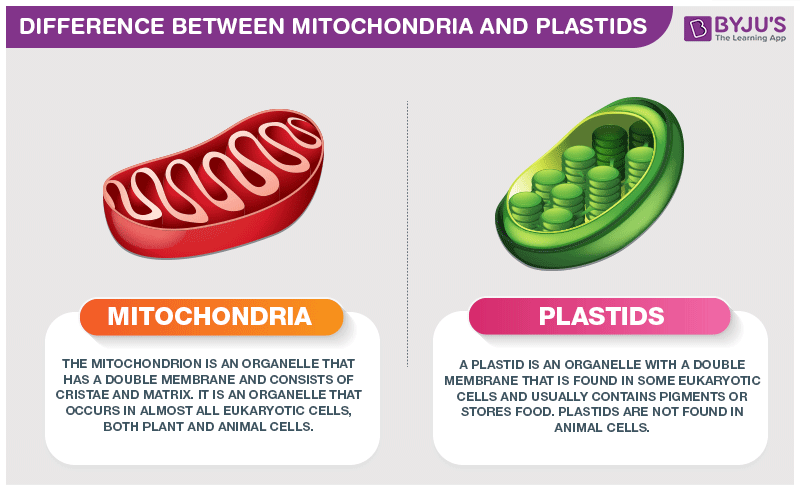Mitochondria and plastids are the cell organelles present in eukaryotes. Mitochondria are found in all eukaryotic cells, including plants and animals, whereas plastids are predominantly found in plant cells as well as algae and protists.
Let us learn the major difference between mitochondria and plastids.
Read more: Aerobic Respiration.
Mitochondria vs Plastids
The important difference between mitochondria and plastids are:

| Difference Between Mitochondria and Plastids | |
|---|---|
| Mitochondria | Plastids |
| Found in all eukaryotic cells | Found in only plant cells (as well as algae and protists) |
| Produces ATP | Produces glucose and stores it as starch |
| The main function is cell respiration | Main organelle for photosynthesis |
| Smaller in size | Comparatively larger in size |
| Pigments are absent | Pigments are present |
Mitochondria
Mitochondria is the powerhouse of the cell. It is an organelle that is responsible for the production of ATP in the cell. This ATP is used as a sort of “currency” for the cell and is primarily used for aerobic respiration.
Plastids
Plastids are similar to mitochondria in that they help in the production and storage of food (glucose). They are found in plants as well as a few other eukaryotes and contain different pigments.
The main difference between mitochondria and plastids is that mitochondria are found in all eukaryotic cells, but plastids are exclusive to plants, algae, protists and a few other eukaryotes.
Also Read: Plastids
Conclusion
Mitochondria and plastids are very important cell organelles that perform different functions. The main difference between mitochondria and plastids is that plastids are present in plants and other aforementioned organisms; mitochondria, on the other hand, are present in all eukaryotic cells.
Explore more: Mitochondria
These were a brief introduction to the difference between mitochondria and plastids. For more information related to other cell organelles, their structure, functions and for other related topics, keep visiting BYJU’S Biology


Comments